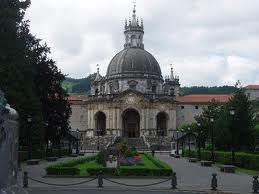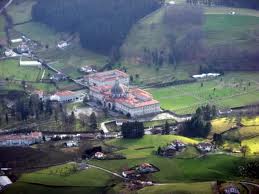 You have surely heard of the Catholic order of the Jesuits, as they are present all over the world. But I´m sure you didn´t know that the founder was born in 1491 in the heart of the Basque Country, in Azpeitia. Iñigo de Loyola (born Iñigo, a Basque name, that he changed later to Ignacio), of a noble family and educated in the best manner, soon became a soldier serving the King of Castile. In 1521 he was injured while battling in Pamplona, and retired to his fortress in the valley of Loiola, near Azpeitia and Azkoitia. During his long recovery he got used to reading religious books, that made him rethink his whole life. Once recovered, he started a life of sanctity that led him to the foundation of the Jesuit order, probably the most influential in the history of the Catholic church.
You have surely heard of the Catholic order of the Jesuits, as they are present all over the world. But I´m sure you didn´t know that the founder was born in 1491 in the heart of the Basque Country, in Azpeitia. Iñigo de Loyola (born Iñigo, a Basque name, that he changed later to Ignacio), of a noble family and educated in the best manner, soon became a soldier serving the King of Castile. In 1521 he was injured while battling in Pamplona, and retired to his fortress in the valley of Loiola, near Azpeitia and Azkoitia. During his long recovery he got used to reading religious books, that made him rethink his whole life. Once recovered, he started a life of sanctity that led him to the foundation of the Jesuit order, probably the most influential in the history of the Catholic church.
The 18th century basilica is located in a beautiful valley, surrounded by a park full of trees and by the Urola river that flows through the mountainous scenery. As you can see by the pictures, it´s a magnificent but at the same time a modest building, with a great dome covered in baroque paintings and designs. On its left hand side you can visit the birthplace of San Ignacio de Loyola, a.k.a. Iñigo de Loyola, that has been beautifully restored to its original state. You can visit both buildings, and in the fortress tower you can see the rooms as they were in the 16th century.
Right by the Basilica (or Sanctuary) there´s a nice, cozy hotel and some rural housings, as well as fine restaurants, in an atmosphere surprisingly almost tourist free. The valley offers very interesting visits, like the Ferrería de Mirandaola (Ironmongery) in the Iron Valley or the town of Idiazabal, where the world famous Idiazabal sheep cheese is made (also, the Cheese Museum deserves a visit).


 One of the main characteristics of the Basque soil is (well, it was) its rich content in high quality iron. Up to the XVI century, there were around 300 foundries! producing iron for all of Europe. Nowadays, iron still plays an important role in our present industrial activity (unfortunately, not as before…). At the very beginning, the foundries were located on top of the mountains and they used the wind as the main force to produce iron, using coal as their source of heat (in a very anti-economical way). Soon they found out
One of the main characteristics of the Basque soil is (well, it was) its rich content in high quality iron. Up to the XVI century, there were around 300 foundries! producing iron for all of Europe. Nowadays, iron still plays an important role in our present industrial activity (unfortunately, not as before…). At the very beginning, the foundries were located on top of the mountains and they used the wind as the main force to produce iron, using coal as their source of heat (in a very anti-economical way). Soon they found out 
 The other one is located in Legazpi, Gipuzkoa, where there formerly were 7 foundries. This one is Ferrería Mirandaola,
The other one is located in Legazpi, Gipuzkoa, where there formerly were 7 foundries. This one is Ferrería Mirandaola, 